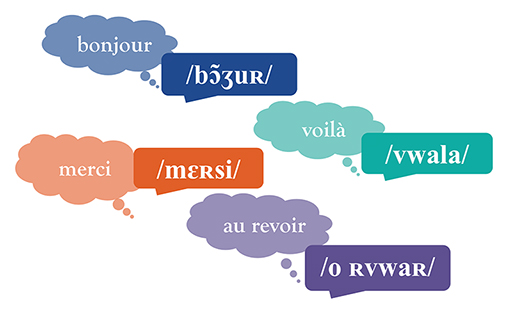3 From letters to sounds
The alphabet used in English and French has 26 letters – but there are more than 26 sounds in the English and in the French languages. This is because, as you saw in the previous activity, diacritics can be used to transcribe different sounds for the same letter (like é and è). Another factor is that letters can be combined to form new sounds. There is, therefore, no direct correspondence between sounds and letters. This is not unique to French, but it does mean that while you study, you will need to ensure that you check how words are pronounced when you learn new vocabulary.
In a beginners’ French course, if you have a tutor they will be able to demonstrate pronunciation, but you will also work with audio and perhaps video clips to practise pronunciation. There are many freely available online dictionaries and translation tools which provide audio clips for pronunciation too. Other resources make use of the International Phonetic Alphabet (IPA) to transcribe sounds. You will come across this when you use a large bilingual dictionary, for example. The IPA is a useful tool for language learners. For example, it distinguishes between the different sounds that the letter ‘e’ and diacritics can spell: the sounds corresponding to the accented letters ‘é’ and ‘è’ are transcribed /e/ and /ɛ/. If you learn a new French word with the letter ‘s’ but are unsure whether it should be pronounced as a soft ‘s’ (as at the start of the word ‘sound’) or like a ‘z’ (for example at the end of the plural ‘sounds’), then checking the phonetic transcription will help you out. Here are a couple of examples of IPA:
The English word ‘sounds’ is transcribed /saʊndz/.
The French word été is transcribed /ete/.
The French word très is transcribed /tʀɛ/.
The International Phonetic Alphabet is a useful tool, but it is complex – even for seasoned linguists. The good news is that as a beginner, you will absolutely not be expected to memorise it, or even use it at all if you don’t want to. But it’s useful to know about it, and to be able to recognise it. Knowing a few of the symbols will provide some handy clues about pronunciation.
Activity 3 Très
Look at the spelling of the French word très, and compare it to the IPA transcription, /tʀɛ/. What does this tell you about how the word is pronounced?
très
/tʀɛ/
Discussion
Comparing the spelling and the IPA transcription of très shows you that the letter ‘s’ is not transcribed phonetically. This means that it is completely silent, and that the word is pronounced as if it was spelt ‘trè’.
Listen to the audio clip below to hear this word again, paying attention to the absence of an ‘s’ sound at the end.

